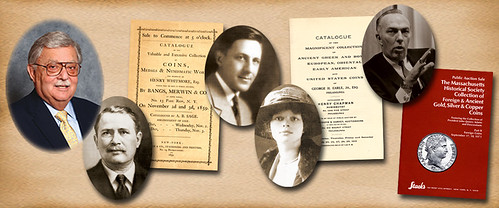
PREV ARTICLE
NEXT ARTICLE
FULL ISSUE
PREV FULL ISSUE
HARVEY STACK ON NUMISMATIC PEDIGREES
In his recent blog posts, Harvey Stack discussed the value of numismatic pedigrees. Here are some excerpts. As an example, Harvey discusses the Adams family collection, sold by the firm in multiple sales in the 1970s.
-Editor

Last time I mentioned the collection of the Adams family of Massachusetts. By the early l830s the members of the family had accumulated thousands upon thousands of documents, showing history and events from our early colonial days, through the War of Independence and the early days of the Industrial Revolution in the 1830s. A depository was established in the recently endowed Massachusetts Historical Society. Many documents, books, coins and currency were placed there for those who wished to study and learn more about the development of the United States of America. The massive collection of coins was given to the Society by John Quincy Adams, along with letters, documents and notes saved from earlier days. The coin collection was carefully housed in large wooden library type cabinets, fitted with drawers to accommodate the extensive collection. The collection included American coins and currency, from pre-colonial days up to about the time of John Quincy Adams, as well as foreign pieces. The collection itself revealed a lot about the economic development of America and reflected the world coins that were available to the members of the Adams family. For many decades the collection resided in the care of the Society and was available for collectors to examine and scholars to study. However, there was no special curator and the care of the coins was not always well attended to. In order to limit the coins’ exposure to various elements, it was decided to store the collection in the Boston Museum of Fine Arts, (currently known as The Museum of Fine Arts or MFA). In the mid 1960s it was discovered that funds were needed to preserve and restore many of the rare history related documents from the Adams Family and other sources. The cost for the project was immense, so the curators of the MFA, under the leadership of Cornelius Vermuele (a senior curator of Antiquities and Numismatic items), recommended that since the coins are rarely if ever seen, they be sold to provide the funds to preserve the important papers of early America. In the late 1960s, after Stack’s was chosen to sell the Adams Family Collection coins, my cousin Norman Stack and I went to Boston and were taken down to the area where the coins were stored. We worked with the curators to select a representative collection that could be retained for display purposes, if so desired, in the halls of the Society. We then made an inventory, packed the coins carefully, and sent them in a large group of special trunks to New York for cataloging and eventual auction. The entire Stack family was thrilled to handle this great American numismatic treasure, realizing the historical importance of its link to the Adams family. It was like being a part of history knowing that for over 150 years these coins had remained first in one family and then housed under their direction in one of the oldest museums in America. The collection was so vast that we used several catalogs to sell them at Public Auction. Each of the lots were put into 2X2 envelopes, stating it was from the Massachusetts Historical Society Collection sold at public auction, then the date of the sale and the lot number. On the rear flap of the envelope it said Stack’s New York. By putting the name of the society, the date of the sale, the lot number, and the auctioneer on the envelope, we established the pedigree of each coin being sold. If the new owner retained it with the coin, this envelope provided a way for the pedigree to continue into the future. Those who attended our first sale in 1970 and the sales that followed speak of the historical importance of the offering and how the retention of the pedigree added to both pride of ownership and the coin’s value. Since then, many catalogs (ours as well as others) offering coins from this historical collection, have noted the envelope to enhance value of the coin. As a final note, the documents that were preserved and saved by the Massachusetts Historical Society became a source for an extensive book about the Adams family. In turn, this book led to a series on Public Television that told the story of the Adams family as revealed by the documents saved and kept by the Society. Working with and cataloging the coins from the Adams Family Collection and learning about the historical items the Adams family passed on, was among the most exciting and satisfying happenings of my numismatic career.
To read the complete articles, see:
To read the earlier E-Sylum article, see:
HARVEY STACK ON NUMISMATIC PEDIGREES
(www.coinbooks.org/esylum_v17n16a14.html)
The Numismatic Bibliomania Society is a non-profit organization promoting numismatic literature. See our web site at coinbooks.org. To submit items for publication in The E-Sylum, write to the Editor at this address: whomren@gmail.com To subscribe go to: https://my.binhost.com/lists/listinfo/esylum All Rights Reserved. NBS Home Page Contact the NBS webmaster 
|